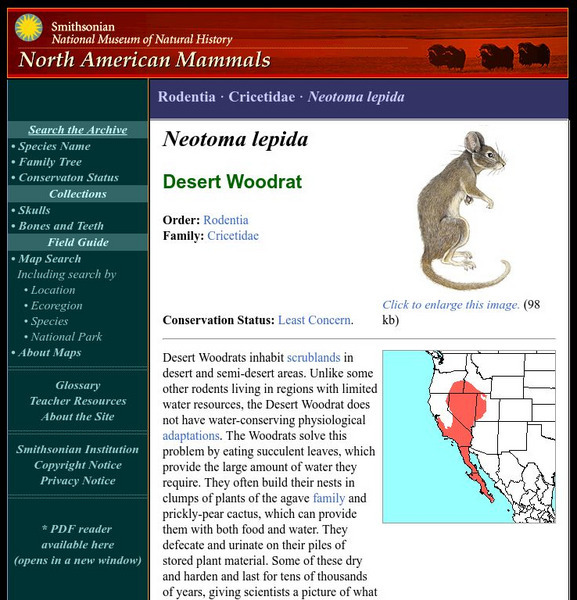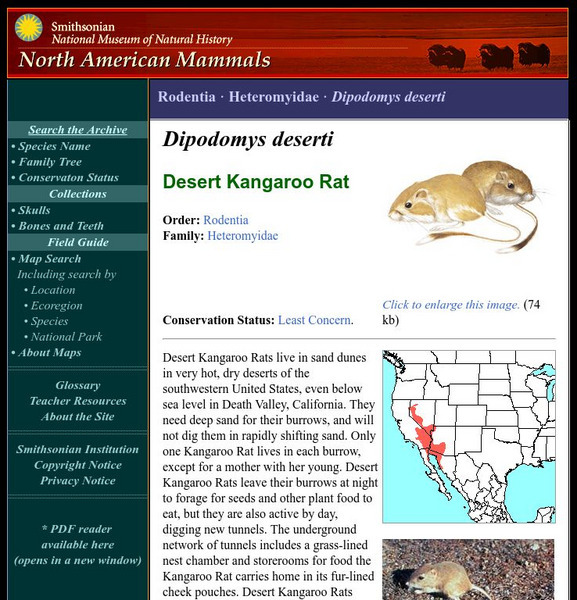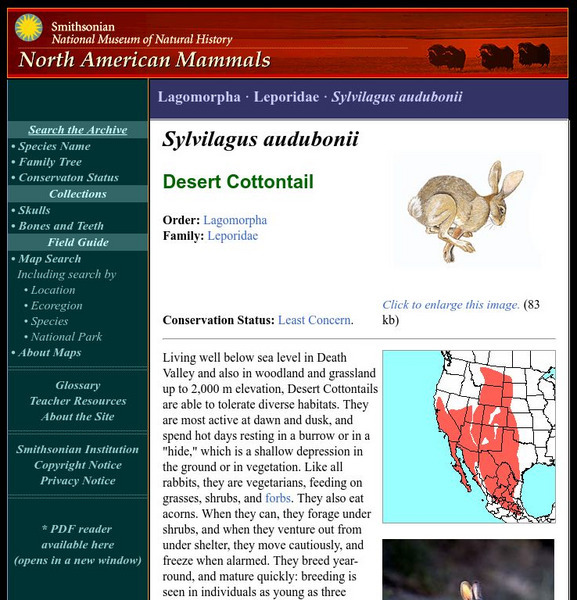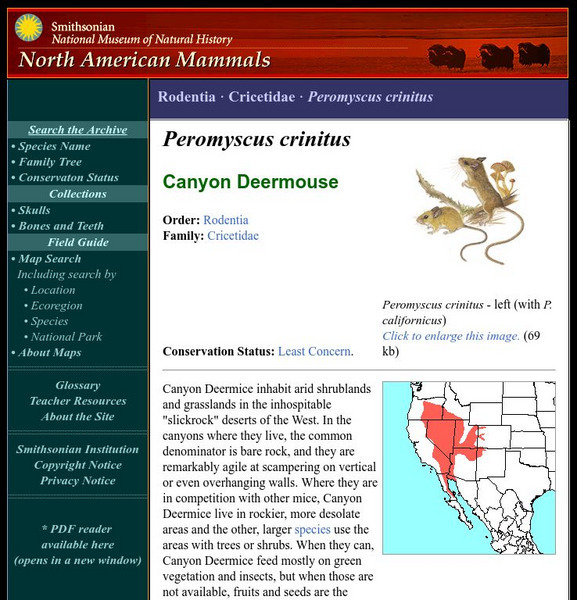Hi, what do you want to do?
History of American Wars
History of American Wars: Operation Desert Storm: Operation Desert Shield
Presents a timeline of events in the Middle East leading up to and during Operation Desert Storm. Begins with the Anglo-Kuwaiti Treaty in 1899.
History of American Wars
History of American Wars: Desert Storm (1990 1991)
Includes a timeline of events and the history behind Operation Desert Storm, a war led by the United States against Iraq in response to Iraq's invasion and annexation of Kuwait.
The History Cat
The History Cat: Geography: Places: Atacama Desert
Describes the Atacama region of Chile and why this area is so dry.
ClassFlow
Class Flow: Sonoran Desert
[Free Registration/Login Required] This flipchart is an introduction/review of the climate, the plant life and the animals of the Sonoran Desert. Students will use Activotes, the eraser tool and the pen tool to answer questions about how...
Blackdog Media
Classic Reader: Desert Gold by Zane Grey
This is the complete text of the American Western novel Desert Gold by Zane Grey.
Blackdog Media
Classic Reader: The Desert of Wheat by Zane Grey
This is the complete text of the American western novel The Desert of Wheat by Zane Grey.
PBS
Nh Pbs: Nature Works: American Kestrel
Can you name the smallest North American falcon? The American Kestrel is the answer to this question. Learn more about this fascinating bird of prey through this resource. Students will find information on the diet, habitat,...
American Museum of Natural History
American Museum of Natural History: O Logy: Fighting Dinos: New Discoveries
A virtual investigation surmising how two fighting dinosaurs died in the Gobi Desert.
Smithsonian Institution
National Museum of Natural History: American Mammals: Hooded Skunk
The Smithsonian National Museum of Natural History, in a section titled "North American Mammals," offers a general overview of the hooded skunk. Content includes detailed drawings, photographs, specimens, and a map showing the skunk's...
National Humanities Center
National Humanities Center: Teacher Serve: Wilderness and American Identity: Challenge of the Arid West
This site from the National Humanities Center provides the story of the struggle to inhabit the West in spite of the dry climate. With questions for student discussion, online resources, scholars debate and bibliography.
American Museum of Natural History
American Museum of Natural History: Gobi Expeditions O Logy Card
Flip this interactive card to start learning about Gobi Expeditions. Answer multiple-choice and fact-or-fiction questions and review some fast facts about this expedition where paleontologists and scientists gather to collect Cretaceous...
Siteseen
Siteseen: American Historama: Operation Desert Storm
Comprehensive resource features interesting facts, a timeline of dates and events, list of battles, and other information on Operation Desert Storm.
University of Illinois
University of Illinois: Modern American Poetry: Robert Frost (1874 1963)
Critical analysis of numerous Frost poems by foremost literary critics like William Pritchard. This is a great resource for students learning how to analyze Frost's poetry.
Houghton Mifflin Harcourt
Harcourt: School Publishers: Exploring Ecosystems
Compare and contrast three very different ecosystems - the Sonoran Desert in Arizona, the Florida Everglades, and the Arctic Coastal Plain in Alaska. Learn what makes each of them unique, and about the adaptations plants and animals had...
Other
The Great Plains in Midwestern Culture
Discusses the history of the people on the Great Plains, both the Native Americans and early settlers.
Smithsonian Institution
National Museum of Natural History: American Mammals: Desert Woodrat
Desert Woodrats inhabit scrublands in desert and semi-desert areas. Unlike some other rodents living in regions with limited water resources, the Desert Woodrat does not have water-conserving physiological adaptations. Learn more about...
Smithsonian Institution
National Museum of Natural History: American Mammals: Desert Kangaroo Rat
Desert Kangaroo Rats live in sand dunes in very hot, dry deserts of the southwestern United States, even below sea level in Death Valley, California. They need deep sand for their burrows, and will not dig them in rapidly shifting sand....
Smithsonian Institution
National Museum of Natural History: American Mammals: Desert Pocket Mouse
The Desert Pocket Mouse is a common inhabitant of warm deserts throughout the United States and Mexico. It prefers sandy soil and avoids rocky settings, and like other pocket mice, comes out at night to search for seeds. Learn more about...
Smithsonian Institution
National Museum of Natural History: American Mammals: Desert Cottontail
Living well below sea level in Death Valley and also in woodland and grassland up to 2,000 m elevation, Desert Cottontails are able to tolerate diverse habitats. They are most active at dawn and dusk and spend hot days resting in a...
Smithsonian Institution
National Museum of Natural History: American Mammals: Desert Pocket Gopher
The Desert Pocket Gopher is built for digging, with strong front legs and massive claws. Small eyes and ears are adaptations for traveling through tunnels. Learn more about the Geomys arenarius, more commonly known as a Desert Pocket...
American Forum for Global Education
American Forum for Global Education: Challenge of the Desert
This elementary exploration of interdependence from the American Forum for Global Education touches on language arts, social studies, and science. Students understand the connection between themselves and their natural environment.
Other
Desert Usa: Harvester Ants
This article about harvester ants examines their behavior, but it also looks at the role these ants play in mythology, especially in Native American stories, and at the social structure of ant colonies. There is also a link to a related...
PBS
Pbs Teachers: Scientific American: About All You Can Eat: Feast or Famine
Investigate the theory that including desert plants such as mesquite and cactus in a diet can help control obesity and diabetes. Design a scientific experiment that will test this hypothesis, using control variables, observation and...
Smithsonian Institution
National Museum of Natural History: American Mammals: Canyon Deermouse
Canyon Deermice inhabit arid shrublands and grasslands in the inhospitable "slickrock" deserts of the West. In the canyons where they live, the common denominator is bare rock, and they are remarkably agile at scampering on vertical or...


























